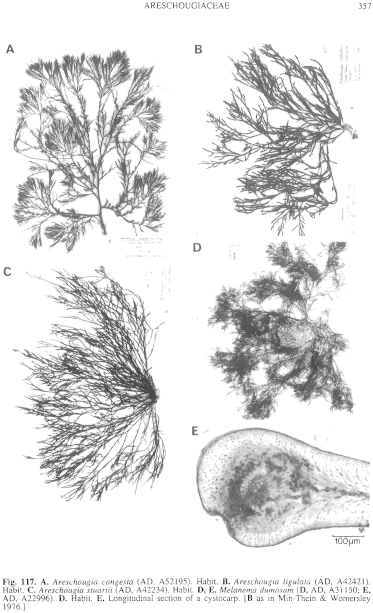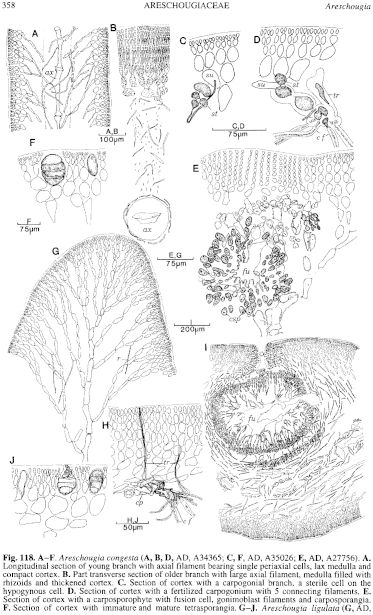|
|
|
|
|
|||||||||||
|
Electronic Flora of South Australia Species Fact Sheet
Phylum Rhodophyta – Class Florideophyceae – Order Gigartinales – Family Areschougiaceae
Selected citations: Lucas & Perrin 1947: 174, fig. 45. Min-Thein & Womersley 1976: 61, figs 20–22, 58A. Silva 1950: 268.
Synonyms
Neoareschougia ligulata (Harvey ex J. Agardh)Kylin 1956: 290, fig. 220D.
Areschougia australis Harvey 1855a: 554; 1858, pl. 13. Kützing 1869: 13, pl. 36d, e. Kylin 1932: 37, fig. 8C–F. NON A. australis (Sonder) Harvey [= Stenocladia australis (Sonder) Silval.
Neoareschougia australis (Harvey) Kylin 1956: 290.
Reproduction: Sexual reproduction non-procarpic. Carpogonial branches (Fig. 118H) 3 (–4)-celled, borne on outer medullary cells, directed inwards or sideways with reflexed trichogynes, occasionally with sterile cells on the lower cells. Connecting filaments (Fig. 118H) 4–7, non-septate and unbranched, uniting with the auxiliary cell (an outer medullary or inner cortical cell), with adjacent cells becoming darkly staining and cutting off nutritive filaments. Gonimoblast initial first inwards, later radial from the fusion cell (with a stalk) and producing short chains (Fig. 118I) of ovoid carposporangia 15–20 ium in diameter. Cystocarps in small clusters of 2–5, protruding on the flat surface of branchlets, with lax filamentous enveloping tissue, ostiolate. Spermatangia unknown.
Tetrasporangia (Fig. 118J) scattered in the cortex of young branches, developed from mid cortical cells and pit-connected basally, ovoid, 40–50 µm long and 20–25 µm in diameter, zonately divided.
Type from W. Aust. (Harvey, Tray. set 173 from Rottnest I.?); holotype? in TCD.
Selected specimens: Geraldton, W. Aust. (MEL, 44848, 44850). Port Denison, W. Aust., drift (Kraft, 14.xii.1971; AD, A41742). Safety Bay, W. Aust., drift (Womersley, 18.viii.1979; AD, A50754). Augusta, W. Aust. (Lucas, Sept. 1928; AD, A578). Pondalowie Bay, S. Aust., drift (Kraft, 19.ix.1973; AD, A44539). Vivonne Bay, Kangaroo I., S. Aust., drift (Womersley, 14.i.1948; AD, A6921 and 2.i.1949; AD, A10732, A10734). Seal Bay, Kangaroo I., S. Aust., drift (Womersley, 21.i.1965; AD, A28597) and (Kraft, 6.iv.1972; AD, A42421). D'Estrees Bay, Kangaroo I., S. Aust., drift (Kraft, 5.iv.1972; AD, A42426).
Distribution: Geraldton, W. Aust., to D'Estrees Bay, Kangaroo I., S. Aust.
Taxonomic notes: Thallus (Fig. 117B) medium to dark red, cartilaginous, 10–35 cm high, much branched irregularly and more or less complanately from the margins at intervals usually of 1–4 cm, branches strongly compressed, (2–) 2.5–4 mm broad in main branches, 2–3 mm in laterals, lesser branchlets 1–2 mm broad, linear with constricted bases and rounded to pointed apices, margin smooth or with small proliferations, with a faint to conspicuous midrib. Holdfast discoid-conical, becoming robust and hapteroid, (2–) 5–20 mm across, with a single stipe; epilithic. Structure (Fig. 118G) uniaxial, with each axial cell cutting off a single periaxial cell on three radii but becoming subopposite on successive cells, forming a lax medulla of periaxial filaments and a pseudoparenchymatous cortex 5–6 cells thick, inner cells ovoid and 20–40 µm in diameter, outer cells 4–6 µm in diameter and L/D 1–2; rhizoidal filaments soon filling the medulla, with the axial filament conspicuous throughout; cortical thickening occurs near the base, especially over the midrib (axial filament). Rhodoplasts discoid, becoming ribbon shaped, several per cell.
Areschougia ligulata appears to be a deep-water alga on rough-water coasts, of western distribution on southern Australian coasts. J. Agardh (1872, p. 26) validated this species originally recognised by Harvey (see Silva 1950, p. 268).
References:
AGARDH, J.G. (1872). Bidrag till Florideernes Systematik. Acta Univ. hind. 8, 1–60.
AGARDH, J.G. (1876). Species Genera et Ordines Algarum. Vol. 3, Part 1 - Epicrisis systematis Floridearum, pp. i-vii, 1–724. (Weigel: Leipzig.)
AGARDH, J.G. (1879). Florideernes morphologi. K. Svenska Vetensk. Akad. Handl. 15(6), 1–199, Plates 1–33.
HARVEY, W.H. (1855a). Some account of the marine botany of the colony of Western Australia. Trans. R. Ir. Acad. 22, 525–566.
HARVEY, W.H. (1858). Phycologia Australica. Vol. 1, Plates 1–60. (Reeve: London.)
KÜTZING, F.T. (1869). Tabulae Phycologicae. Vol. 19. (Nordhausen.)
KYLIN, H. (1932). Die Florideenordnung Gigartinales. Lunds Univ. Årsskr. N.F. Avd. 2, 28 (8), 1–88, Plates 1–28.
KYLIN, H. (1956). Die Gattungen der Rhodophyceen. (Gleerups: Lund.)
LUCAS, A.H.S. & PERRIN, F. (1947). The Seaweeds of South Australia. Part 2. The Red Seaweeds. (Govt Printer: Adelaide.)
MIN-THEIN, U. & WOMERSLEY, H.B.S. (1976). Studies on southern Australian taxa of Solieriaceae, Rhabdoniaceae and Rhodophyllidaceae (Rhodophyta). Aust. J. Bot. 24, 1–166.
SILVA, P.C. (1950). Generic names of algae proposed for conservation. Hydrobiologia 2, 252–280.
The Marine Benthic Flora of Southern Australia Part IIIA complete list of references.
Publication:
Womersley, H.B.S. (14 January, 1994)
The Marine Benthic Flora of Southern Australia
Rhodophyta. Part IIIA, Bangiophyceae and Florideophyceae (to Gigartinales)
Reproduced with permission from The Marine Benthic Flora of Southern Australia Part IIIA 1994, by H.B.S. Womersley. Australian Biological Resources Study, Canberra. Copyright Commonwealth of Australia.
Illustrations in Womersley Part IIIA, 1994: FIGS 117B, 118 G–J.

Figure 117 enlarge
Fig. 117. A. Areschougia congesta (AD, A52195). Habit. B. Areschougia ligulata (AD, A42421). Habit. C. Areschougia stuartii (AD, A42234). Habit. D, E. Melanema dumosum (D, AD, A31150; E, AD, A22996). D. Habit. E. Longitudinal section of a cystocarp. [B as in Min-Theis & Womersley 1976.]

Figure 118 enlarge
Fig. 118. A–F. Areschougia congesta (A, B, D, AD, A34365; C, F, AD, A35026; E, AD, A27756). A. Longitudinal section of young branch with axial filament bearing single periaxial cells, lax medulla and compact cortex. B. Part transverse section of older branch with large axial filament, medulla filled with rhizoids and thickened cortex. C. Section of cortex with a carpogonial branch, a sterile cell on the hypogynous cell. D. Section of cortex with a fertilized carpogonium with 5 connecting filaments. E. Section of cortex with a carposporophyte with fusion cell, gonimoblast filaments and carposporangia. F. Section of cortex with immature and mature tetrasporangia. G–J. Areschougia ligulata (G, AD, A28597; H, AD, A6921; I, AD, A10734; J, AD, A10732). G. Longitudinal section of branch apex. H. Section of cortex with a carpogonial branch (on left) and a fertilized carpogonium with several connecting filaments. I. Section of branch and a carposporophyte, with fusion cell and chains of carposporangia, ostiole, and slight enveloping tissue (with germinating carposporangia). J. Section of cortex with immature and mature tetrasporangia (the upper spore developing). [A–J after Min-Thein & Womersley 1976.]

|
Email Contact: State Herbarium of South Australia |

|